There’s a lot going on in recruitment right now. Innovative technology is changing the way recruitment works. Chatbots can help us screen resumes and schedule interviews, video software enables us to interview candidates from all over the world, and specialized feedback tools gather applicant feedback that helps us optimize the candidate experience.
A main driver behind a lot of the innovation we see in recruitment-land is the use of data, AI and predictive analytics (PA). You may not know it, but applications of PA are all around us. From Netflix suggesting series you might like to watch to Google finishing your sentences when you start typing something in its search engine.

Thank you Google, for finishing my sentences.
In recruitment, the potential of predictive analytics is endless: from job advertising and preselection to onboarding and funnel optimization, virtually every aspect of recruitment can be streamlined and optimized with an adequate PA-infused recruitment solution.
Still not convinced? here are some stats to get your enthusiasm up:
According to ideal, the use of predictive analytics in your recruitment process can save you up to 23 hours of manual labor a week! Mainly in terms of the time it takes to shortlist and pre-screen candidates.
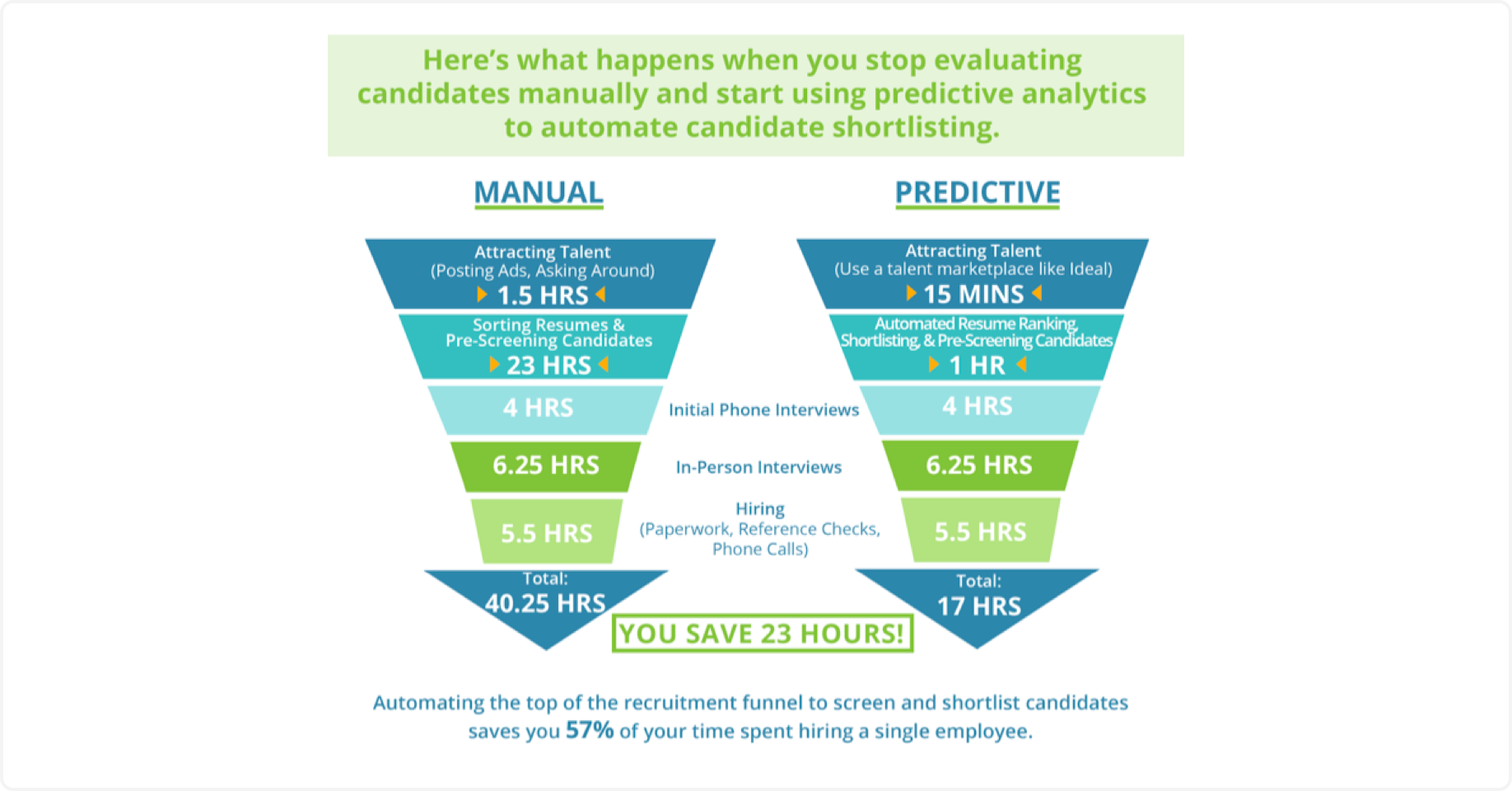
Ideal researched what Predictive Analytics can do
to a standard recruiting funnel.
And, we know, you’re not a data expert or coding wizard. So what does this have to do with you?
Although you don’t have to be a data expert or coding wizard to stay on top of your game, it does help when you get the basics of what’s going on behind all the data-dashboards, pre-selection software, and candidate rankings.
We know the subject may look daunting at first, but in this article, we’ll explain everything you need to know about predictive analytics in recruitment: What it is, how it works, and how it is applicable to recruitment. Of course, with tangible examples.
Alright, let’s go!
What’s in?
Like what you see?
Don’t miss out. Subscribe to our quarterly digest to get the latest TA and TM resources delivered right to your inbox.
What is predictive analytics?
Put simply, Predictive Analytics is the use of historical data to make predictions about the future. This means you look at information from the past in order to determine the likelihood of a future outcome. Let’s have a look at an example.
Mrs. Jones has a thing for vintage designer bags. Every 4-5 months for the past 6 years she’s bought a unique creation and logged the details of her vintage bag collection in an excel file.
With the help of the right predictive model (we’ll get to that later), it’s possible to predict for instance when Mrs. Jones is going to buy her next designer bag and whether she’ll buy a clutch, a tote, or satchel.
Before we explain the basics, let’s zoom out for a minute.
Types of analytics
What you need to know is that Predictive Analytics is one of 3 main types of analytics:
- Descriptive Analytics
- Predictive Analytics
- Prescriptive Analytics
We’ll walk you through each type of analytics.
Descriptive Analytics
Descriptive analytics focuses on describing something that happened in the past. Think about the number of applicants in your ATS or the number of people working at your company for instance.
Predictive Analytics
Predictive analytics is all about what could happen. A mix of statistical, machine learning, and modeling techniques can create a ‘predictive model’ that gives estimations about the likelihood of a future outcome (the chances that Mrs. Jones’ next purchase will be a vintage Chanel evening clutch for example).
Predictive analytics enable organizations – and HR departments – to make data-backed decisions about the future.
Prescriptive analytics
Prescriptive analytics takes things one step further and concentrates on what should we do. It’s about finding the best course of action in a specific situation. Multiple future outcomes for different decisions are predicted based on various elements. This allows users of Prescriptive Analytics to prescribe a number of actions that need to be taken as well as their outcomes.
Prescriptive analytics is still relatively new in the world of analytics and not commonly used yet. Perhaps the most commonly known example of prescriptive analytics ‘in real life’ is the self-driving car; during every trip, the car has numerous decisions to make – whether to turn left or right, to stop or not to stop etc. – based on several future possibilities.
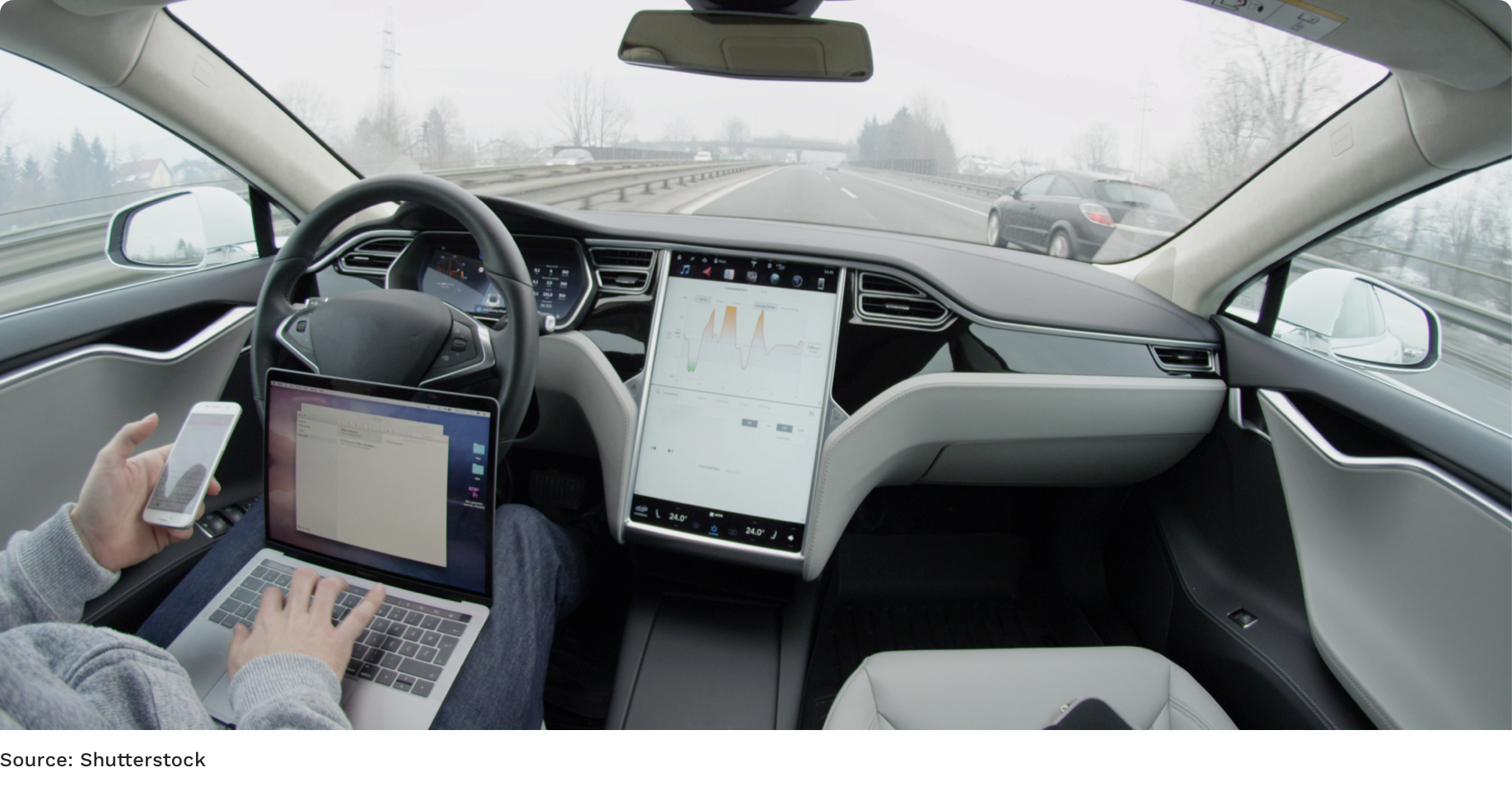
Self-driving cars have to assess numerous outcomes
based on a whole lot of data
How does it work?
Alright, since we’ve got the various types of analytics covered now, it’s time to dive deeper into the mechanics of PA.
The basic concept of Predictive Analytics is as follows: first, you collect data. Then you clean and analyze it and look for patterns to predict future outcomes. Sounds simple, right?
Yes and no.
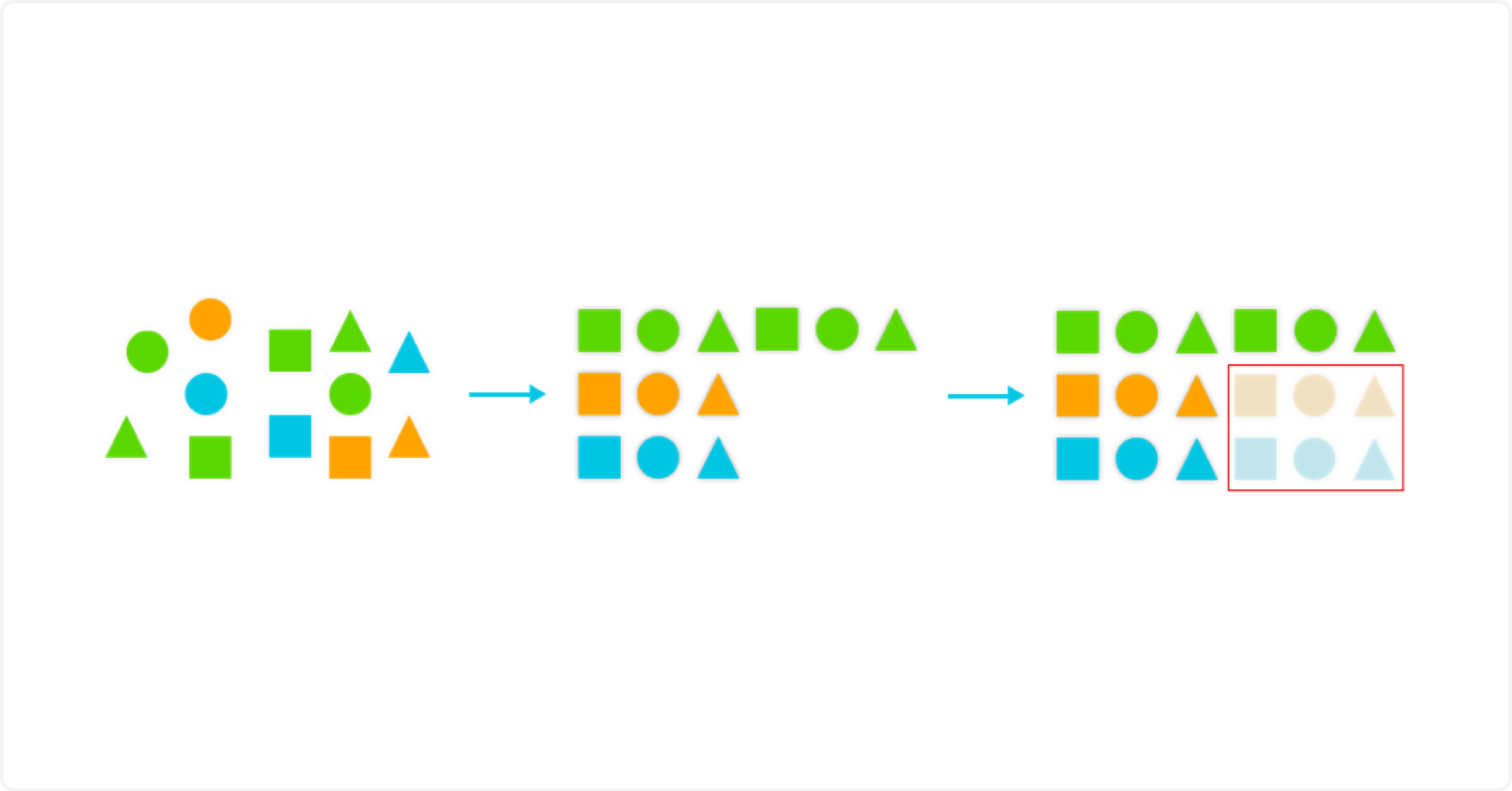
the predictive cycle simplified.
Data collection, recognizing patterns and making predictions
The concept indeed isn’t that difficult to understand, but working in the field of Predictive Analytics has a bit more to it. There’s a little something called the predictive cycle, which you follow step by step to get a conclusion.
Roughly, the predictive cycle consists of 6 steps:
The Predictive Cycle
1. Collect data
Depending on what you want to know, you collect data from multiple sources. A data source can be anything. If you track the amount of bags Mrs. Jones purchases on a yearly basis, that’s a data source. If you measure the number of productive hours per employee, that’s a data source too. If done right, the rule of thumb is that the more (right) data sources you pick, the better your predictions get.
2. Pre-process data
Once you’ve collected all the relevant data, it’s time for phase 2, also known as the most time-consuming stage of the predictive cycle: the pre-processing stage. This is when the data is cleaned, formatted, combined, and sampled. In short: the data is being processed in such a way that it’s ready to be used in a ‘predictive model’.
3. Establish the type of analysis
Based on what you encounter during the pre-processing stage and the results you’re looking for, you establish the type of analysis you want to run and you pick a predictive model.
There are tons of different predictive models out there with different outcomes, such as decision trees, neural networks, or random forests (who knew data people were such nature-lovers). Your go-to machine learning and Data Analytics expert will know which one to use when.
4. Training of the predictive model
Next up, the training phase. Just like you need to be trained to run 20 miles, a predictive model needs to be trained to be able to make predictions. This means you let your model take a test drive with a big chunk of data to see how it reacts. If you pour in enough data, you get representative outcomes based on which you can make estimations for future data.
A simple example: After 10.000 candidates (= training data), 85% of them are still in service after 3 months. You can now say with a high degree of certainty that of the next 100 candidates, around 85 will still be in service after three months.
5. Perform predictions
This is when the fun begins. After all the collecting, pre-processing, analysis establishing and training of the model, it’s future-telling time.
6. Act on insights
Of course, it doesn’t stop after you’ve got your scores, graphs, and percentages, the idea is for you to act on the insights you’ve gained. To use them to optimize your process.
How is this applicable to recruitment?
We briefly mentioned how predictive analytics can be used to improve your recruitment funnel, but let’s take a closer look at some elements.
Sourcing & Attracting Talent
The use of, for instance, a talent marketplace to attract talent, and data-driven tools to automate resume ranking, shortlisting, and pre-screening candidates can save recruiters heaps of time. And not just that, it increases the quality – and diversity – of the candidates too. In short, predictive analytics can increase the effectiveness and efficiency of your hiring process.
Job adverts response
Along the same lines, predictive analytics can help organizations to optimize their job adverts response. Based on elements such as industry, location, occupation etc. data analysis can provide companies customized recommendations on how to get better responses to their job postings.
Talent pipelining
Another example mentioned by Jean-Paul Isson is talent pipelining. PA can help you optimize your talent pipeline by leveraging off macro-economic and talent data. Eventually, this leads to better resource allocation. Think of identifying the best locations to invest in recruitment campaigns for specific skills for example.
And there’s a big one we haven’t mentioned yet:
An in-depth example: Predictive Analytics and preselection
At Harver, we’ve developed a pre-hiring platform infused with PA. Here’s how it works (keep in mind, the system has a front- and backend, respectively for candidates and recruiters):
Candidates enter an engaging, online environment that takes them on a virtual journey through your company. Think of it as an online day at the office.
While they’re touring the office, candidates are presented with – based on your preferences – a selection of real life, on-the-job scenarios and a variety of hard and soft skill assessments.
Once they’ve completed the process, the applicants get an individual feedback report that indicates how they scored on the various parts of the pre-selection test.
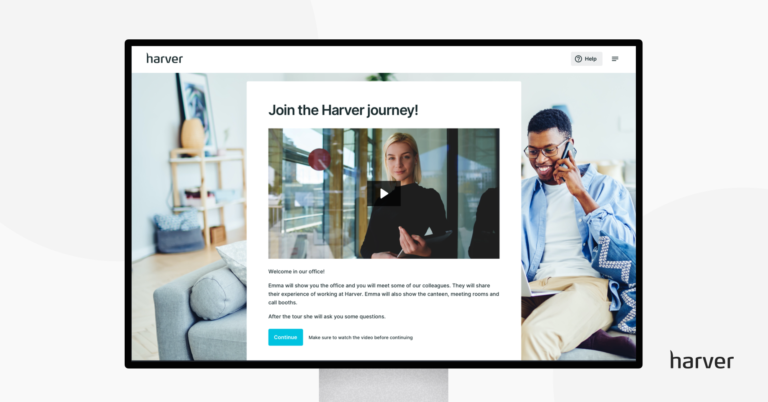
Candidates go through an engaging experience that shows
them your organization, the job, and the office.
What happens behind the scenes?
While the candidates navigate through the different stages of the online assessment, data is gathered from their input after which our self-learning algorithms calculate a matching score. In short: a score that defines to what extent an applicant fits your organization.

The matching score indicates – among other things – how likely it is that a certain candidate will be successful in the role he or she is applying for, but also the likelihood of someone fitting into your company culture.
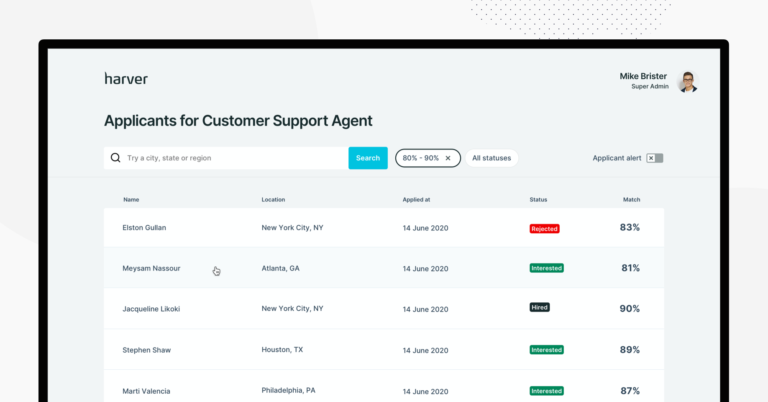
The backend displays your applicants in one clear
overview with corresponding matching scores.
As such, using a data-driven preselection tool like Harver can be a great instrument to support you in your decision-making process. And the best thing?
It benefits all of those involved! Recruiters get all the information they need to improve their hiring decisions drastically while applicants get a fun, engaging, and smooth experience. Win-win.
Conclusion
There you have it, a comprehensive look at Predictive Analytics in Recruitment. Hopefully, it has demystified the concept of predictive analytics for you and given you a basic idea about the way PA works and its applications in recruitment.
If you’d like to see how our software can help improve the experience of your candidates, while enabling your recruiting team to make data-driven decissions, book a demo below.
Ready to transform your hiring process?


